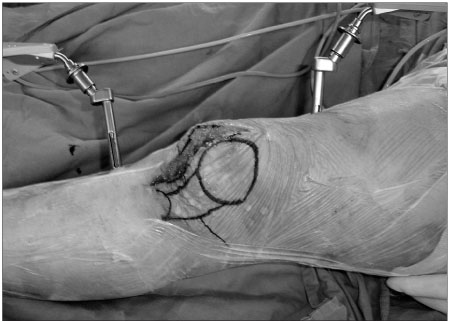J Korean Orthop Assoc.
2007 Apr;42(2):190-195. 10.4055/jkoa.2007.42.2.190.
Comparisons of 1 Year Follow-up Results between Navigation Assisted Minimally Invasive and Conventional Techniques in Bilateral Total Knee Arthroplasty
- Affiliations
-
- 1Department of Orthopedics, Chonnam National University School of Medicine, Gwangju, Center for Joint Disease, Chonnam National University Hwasun Hospital, Jeonnam, Korea. eksong@chonnam.ac.kr
- KMID: 854587
- DOI: http://doi.org/10.4055/jkoa.2007.42.2.190
Abstract
- PURPOSE: This study compared the clinical and radiological results using navigation assisted minimally invasive (NA-MIS) and conventional (CON) techniques in forty-two patients, who underwent bilateral TKA with a minimum follow-up of one-year. MATERIALS AND METHODS: The clinical evaluations were performed using ROM, HSS, and Western Ontario and McMaster University (WOMAC) scores at 3, 6 and 9 months, and 1 year after surgery. The patients' subjective preferences and radiological indices, including the mechanical axis and coronal inclinations of the prostheses, were compared at 1 year after surgery. RESULTS: The NA-MIS TKA showed better HSS and WOMAC total scores than CON TKA up to six months. However, these differences were not significant 1 year after surgery. The ROM and other WOMAC scores were comparable in both groups at all times. More patients preferred the NA-MIS side to the CON side. The radiological results showed similar mean values between the two surgical groups, even though the NA-MIS group contained fewer outliers than the CON group. CONCLUSION: Navigation assisted minimal invasive TKA is associated with better clinical results up to 6 months after surgery and shows fewer outlier results. However, the mean values in leg alignment were similar to those of conventional TKA.
Figure
Reference
-
1. Bonutti PM, Neal DJ, Kester M. Minimal incision total knee arthroplasty using the suspended leg technique. Orthopedics. 2003. 26:899–903.
Article2. Dalury DF, Dennis DA. Mini-incision total knee arthroplasty can increase risk of component malalignment. Clin Orthop Relat Res. 2005. 440:77–81.
Article3. Haas SB, Cook S, Beksac B. Minimally invasive total knee replacement through a mini midvastus approach: a comparative study. Clin Orthop Relat Res. 2004. 428:68–73.4. Kanlic EM, Delarosa F, Pirela-Cruz M. Computer assited orthopaedic surgery--CAOS. Bosn J Basic Med Sci. 2006. 6:7–13.5. Laskin RS. New techniques and concepts in total knee replacement. Clin Orthop Relat Res. 2003. 416:151–153.6. Laskin RS, Beksac B, Phongjunakorn A, et al. Minimally invasive total knee replacement through a mini-midvastus incision: an outcome study. Clin Orthop Relat Res. 2004. 428:74–81.7. Seon JK, Song EK. The accuracy of lower extremity alignment in a total knee arthroplasty using computer-assisted navigation system. J Korean Orthop Assoc. 2004. 39:566–571.
Article8. Seon JK, Song EK. Navigation-assisted less invasive total knee arthroplasty compared with conventional total knee arthroplasty: a randomized prospective trial. J Arthroplasty. 2006. 21:777–782.9. Sparmann M, Wolke B, Czupalla H, Banzer D, Zink A. Positioning of total knee arthroplasty with and without navigation support. A prospective, randomized study. J Bone Joint Surg Br. 2003. 85:830–835.10. Stulberg SD, Loan P, Sarin V. Computer-assisted navigation in total knee replacement: results of an initial experience in thirty-five patients. J Bone Joint Surg. 2002. 84:Suppl 2. 90–98.11. Tria AJ Jr. Advancements in minimally invasive total knee arthroplasty. Orthopedics. 2003. 26:8 Suppl. S859–S863.
Article12. Tria AJ Jr. Minimally invasive total knee arthroplasty: the importance of instrumentation. Orthop Clin North Am. 2004. 35:227–234.
Article13. Victor J, Hoste D. Image-based computer-assisted total knee arthroplasty leads to lower variability in coronal alignment. Clin Orthop Relat Res. 2004. 428:131–139.
Article
- Full Text Links
- Actions
-
Cited
- CITED
-
- Close
- Share
- Similar articles
-
- Blood Loss of Image-free Navigation Assisted Minimal Invasive total Knee Arthroplasty
- Minimally Invasive Total Knee Arthroplasty
- Effects of Femoral Lateral Bowing on Coronal Alignment and Component Position after Total Knee Arthroplasty: A Comparison of Conventional and Navigation-Assisted Surgery
- Computer Assisted Navigation in Knee Arthroplasty
- Computer-Assisted Navigation in Total Knee Arthroplasty



